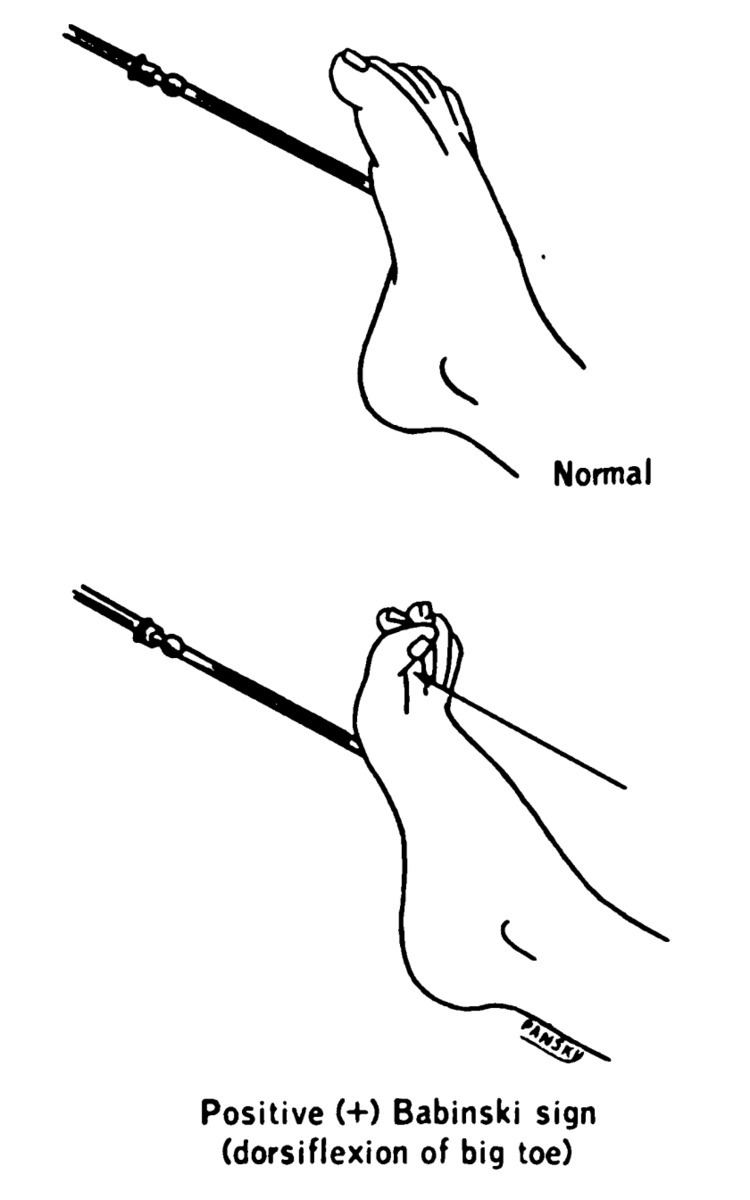ICD-9-CM 796.1 | MedlinePlus 003294 | |
 | ||
The plantar reflex is a reflex elicited when the sole of the foot is stimulated with a blunt instrument. The reflex can take one of two forms. In normal adults, the plantar reflex causes a downward response of the hallux (flexion). An upward response (extension) of the hallux is known as the Babinski response or Babinski sign, named after the neurologist Joseph Babinski. The presence of the Babinski sign can identify disease of the spinal cord and brain in adults, and also exists as a primitive reflex in infants.
Contents
Methods
The lateral side of the sole of the foot is rubbed with a blunt instrument or device so as not to cause pain, discomfort, or injury to the skin; the instrument is run from the heel along a curve to the toes (metatarsal pads). Many reflex hammers taper at the end of the handle to a point which was used for testing the plantar response in the past, however, due to the tightening of infection control regulation this is no longer recommended. Either a single use orange stick or the thumb nail should be used.
There are three responses possible:
As the lesion responsible for the sign expands, so does the area from which the afferent Babinski response may be elicited. The Babinski response is also normal while asleep and after a long period of walking.
Interpretation
The Babinski sign can indicate upper motor neuron lesion constituting damage to the corticospinal tract. Occasionally, a pathological plantar reflex is the first and only indication of a serious disease process and a clearly abnormal plantar reflex often prompts detailed neurological investigations, including CT scanning of the brain or MRI of the spine, as well as lumbar puncture for the study of cerebrospinal fluid.
The phrase "negative Babinski sign" is sometimes used for the normal flexor plantar response.
In infants
Infants will also show an extensor response. A baby's smaller toes will fan out and their big toe will dorsiflex slowly. This happens because the corticospinal pathways that run from the brain down the spinal cord are not fully myelinated at this age, so the reflex is not inhibited by the cerebral cortex. The extensor response disappears and gives way to the flexor response around 12 to 24 months of age.
Negative or diminished response of plantar reflex during early infancy is highly suggestive of neurologic abnormalities, especially for spasticity. Infants with such findings need careful observation for possible development of neurologic abnormalities.
Pathways
Afferent: Nociception detected in the S1 dermatome and travels up the tibial nerve to the sciatic nerve to roots of L5,S1 and synapse in the anterior horn to elicit the motor response. Efferent: Motor response back through the L5,S1 roots to the sciatic nerve to its bifurcation. Toe flexors are innervated by the tibial nerve. Toe extensors (extensor hallicus longus, extensor digitorum longus) are innervated by the deep peroneal nerve. Loss of normal adult descending pyramidal control of the reflex arc to suppress extensor withdrawal results in the upgoing toes in the plantar reflex known as Babinski's sign.
Relationship to Hoffmann's reflex
The Hoffmann's reflex is sometimes described as the upper limb equivalent of the Babinski sign because both indicate upper motor neuron dysfunction. Mechanistically, they differ significantly; the finger flexor reflex is a simple monosynaptic spinal reflex involving the flexor digitorum profundus that is normally fully inhibited by upper motor neurons. The pathway producing the plantar response is more complicated, and is not monosynaptic.
Babinski-like responses
The plantar reflex can be elicited in a number of ways, which were described in the late 19th and early 20th century. These have their own eponyms.
